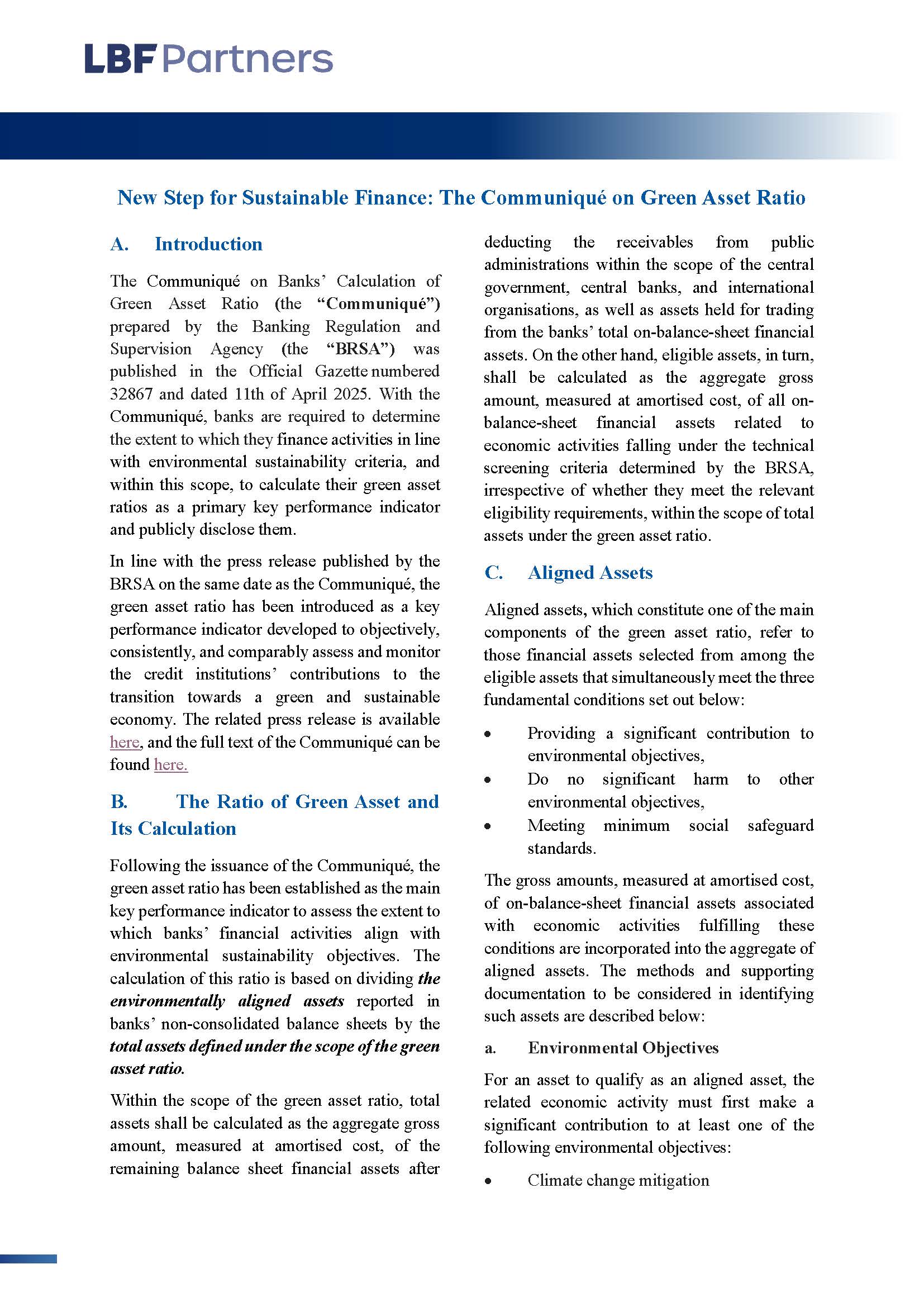New Step for Sustainable Finance: The Communiqué on Green Asset Ratio
A. Introduction
The Communiqué on Banks’ Calculation of Green Asset Ratio (the “Communiqué”) prepared by the Banking Regulation and Supervision Agency (the “BRSA”) was published in the Official Gazette numbered 32867 and dated 11th of April 2025. With the Communiqué, banks are required to determine the extent to which they finance activities in line with environmental sustainability criteria, and within this scope, to calculate their green asset ratios as a primary key performance indicator and publicly disclose them.
In line with the press release published by the BRSA on the same date as the Communiqué, the green asset ratio has been introduced as a key performance indicator developed to objectively, consistently, and comparably assess and monitor the credit institutions’ contributions to the transition towards a green and sustainable economy. The related press release is available here, and the full text of the Communiqué can be found here.
B. The Ratio of Green Asset and Its Calculation
Following the issuance of the Communiqué, the green asset ratio has been established as the main key performance indicator to assess the extent to which banks’ financial activities align with environmental sustainability objectives. The calculation of this ratio is based on dividing the environmentally aligned assets reported in banks’ non-consolidated balance sheets by the total assets defined under the scope of the green asset ratio.
Within the scope of the green asset ratio, total assets shall be calculated as the aggregate gross amount, measured at amortised cost, of the remaining balance sheet financial assets after deducting the receivables from public administrations within the scope of the central government, central banks, and international organisations, as well as assets held for trading from the banks’ total on-balance-sheet financial assets. On the other hand, eligible assets, in turn, shall be calculated as the aggregate gross amount, measured at amortised cost, of all on-balance-sheet financial assets related to economic activities falling under the technical screening criteria determined by the BRSA, irrespective of whether they meet the relevant eligibility requirements, within the scope of total assets under the green asset ratio.
C. Aligned Assets
Aligned assets, which constitute one of the main components of the green asset ratio, refer to those financial assets selected from among the eligible assets that simultaneously meet the three fundamental conditions set out below:
The gross amounts, measured at amortised cost, of on-balance-sheet financial assets associated with economic activities fulfilling these conditions are incorporated into the aggregate of aligned assets. The methods and supporting documentation to be considered in identifying such assets are described below:
a. Environmental Objectives
For an asset to qualify as an aligned asset, the related economic activity must first make a significant contribution to at least one of the following environmental objectives:
In determining such contribution, the technical screening criteria established by the BRSA are taken as the basis. Banks are required to substantiate compliance with these criteria through independent verification reports (e.g., emission reports, feasibility studies, energy efficiency assessments), certificates, or investment documents.
b. Do No Significant Harm to Environment
Second, while contributing to one of the environmental objectives mentioned above, the economic activity must not cause significant harm to the other objectives. In this assessment, the environmental impacts of the activity, as well as those of the products or services generated throughout their life cycle and after their end-of-life stage, are taken into consideration. These criteria will also be determined by the BRSA, and the responsibility for providing the necessary documentation rests with the banks.
c. Minimum Social Safeguard Standards
Finally, activities to be considered as aligned, as well as the relevant parties, must comply with minimum social safeguard standards. Within this scope, principles of social responsibility such as respect for human rights, fair working conditions, and occupational health and safety are taken into account. Furthermore, banks are responsible for documenting compliance with these standards and retaining the documentation in a manner ready for audit.
D. Reporting
Banks are obliged to establish certification, classification, monitoring, and control processes regarding the assets taken into account in the calculation of the green asset ratio and to define institutional policies related to these processes. In addition, it is the responsibility of the banks to set up the necessary data infrastructure to ensure the sound functioning of these processes and to implement a comprehensive reporting system. The BRSA is authorized to determine and differentiate reporting obligations based on the type and size of banks. Reporting on the green asset ratio shall be submitted to the BRSA within the specified timeframes. In this context, reporting to the BRSA commenced on 30 June 2025.
E. Secondary Indicators and Thresholds
While the Communiqué defines the green asset ratio as the primary key performance indicator, it also grants the BRSA the authority to introduce new indicators.
In addition, with the aim of enhancing banks’ performance in the green asset ratio and other indicators, the BRSA may set thresholds and targets, and impose necessary measures including additional capital requirements on banks that fail to meet these obligations.
The Communiqué on Banks’ Calculation of Green Asset Ratio (the “Communiqué”) prepared by the Banking Regulation and Supervision Agency (the “BRSA”) was published in the Official Gazette numbered 32867 and dated 11th of April 2025. With the Communiqué, banks are required to determine the extent to which they finance activities in line with environmental sustainability criteria, and within this scope, to calculate their green asset ratios as a primary key performance indicator and publicly disclose them.
In line with the press release published by the BRSA on the same date as the Communiqué, the green asset ratio has been introduced as a key performance indicator developed to objectively, consistently, and comparably assess and monitor the credit institutions’ contributions to the transition towards a green and sustainable economy. The related press release is available here, and the full text of the Communiqué can be found here.
B. The Ratio of Green Asset and Its Calculation
Following the issuance of the Communiqué, the green asset ratio has been established as the main key performance indicator to assess the extent to which banks’ financial activities align with environmental sustainability objectives. The calculation of this ratio is based on dividing the environmentally aligned assets reported in banks’ non-consolidated balance sheets by the total assets defined under the scope of the green asset ratio.
Within the scope of the green asset ratio, total assets shall be calculated as the aggregate gross amount, measured at amortised cost, of the remaining balance sheet financial assets after deducting the receivables from public administrations within the scope of the central government, central banks, and international organisations, as well as assets held for trading from the banks’ total on-balance-sheet financial assets. On the other hand, eligible assets, in turn, shall be calculated as the aggregate gross amount, measured at amortised cost, of all on-balance-sheet financial assets related to economic activities falling under the technical screening criteria determined by the BRSA, irrespective of whether they meet the relevant eligibility requirements, within the scope of total assets under the green asset ratio.
C. Aligned Assets
Aligned assets, which constitute one of the main components of the green asset ratio, refer to those financial assets selected from among the eligible assets that simultaneously meet the three fundamental conditions set out below:
- Providing a significant contribution to environmental objectives,
- Do no significant harm to other environmental objectives,
- Meeting minimum social safeguard standards.
The gross amounts, measured at amortised cost, of on-balance-sheet financial assets associated with economic activities fulfilling these conditions are incorporated into the aggregate of aligned assets. The methods and supporting documentation to be considered in identifying such assets are described below:
a. Environmental Objectives
For an asset to qualify as an aligned asset, the related economic activity must first make a significant contribution to at least one of the following environmental objectives:
- Climate change mitigation
- Climate change adaptation
- Transition to a circular economy
- Sustainable use and protection of water and marine resources
- Pollution prevention and control
- Protection and restoration of biodiversity and ecosystems
In determining such contribution, the technical screening criteria established by the BRSA are taken as the basis. Banks are required to substantiate compliance with these criteria through independent verification reports (e.g., emission reports, feasibility studies, energy efficiency assessments), certificates, or investment documents.
b. Do No Significant Harm to Environment
Second, while contributing to one of the environmental objectives mentioned above, the economic activity must not cause significant harm to the other objectives. In this assessment, the environmental impacts of the activity, as well as those of the products or services generated throughout their life cycle and after their end-of-life stage, are taken into consideration. These criteria will also be determined by the BRSA, and the responsibility for providing the necessary documentation rests with the banks.
c. Minimum Social Safeguard Standards
Finally, activities to be considered as aligned, as well as the relevant parties, must comply with minimum social safeguard standards. Within this scope, principles of social responsibility such as respect for human rights, fair working conditions, and occupational health and safety are taken into account. Furthermore, banks are responsible for documenting compliance with these standards and retaining the documentation in a manner ready for audit.
D. Reporting
Banks are obliged to establish certification, classification, monitoring, and control processes regarding the assets taken into account in the calculation of the green asset ratio and to define institutional policies related to these processes. In addition, it is the responsibility of the banks to set up the necessary data infrastructure to ensure the sound functioning of these processes and to implement a comprehensive reporting system. The BRSA is authorized to determine and differentiate reporting obligations based on the type and size of banks. Reporting on the green asset ratio shall be submitted to the BRSA within the specified timeframes. In this context, reporting to the BRSA commenced on 30 June 2025.
E. Secondary Indicators and Thresholds
While the Communiqué defines the green asset ratio as the primary key performance indicator, it also grants the BRSA the authority to introduce new indicators.
In addition, with the aim of enhancing banks’ performance in the green asset ratio and other indicators, the BRSA may set thresholds and targets, and impose necessary measures including additional capital requirements on banks that fail to meet these obligations.








 Download PDF
Download PDF

 e.copur@lbfpartners.com
e.copur@lbfpartners.com
